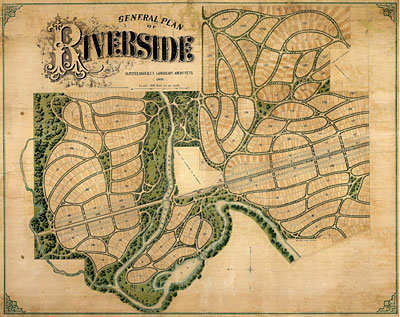A Beautiful ‘Burb
Suburbs are ubiquitous today — and much maligned. But in 1868, when Olmsted did his masterful plan for Riverside, Illinois, a suburb was nothing short of a revolutionary new way of living.
During this era, most Americans still lived in the country where the air was clean but the infrastructure, nonexistent. Want running water? Run and fetch some from the well. Increasingly, people were migrating to cities where culture and amenities were available. But cities had their own set of ills: overcrowding, crime, filth. Riverside was to be the golden mean between the two modes of living. As an 1871 promotional brochure crows, it would combine  “the conveniences peculiar to the finest modern cities, with the domestic advantages of the most charming country, in a degree never before realized.”
Olmsted fairly well delivered on this promise. His plan (below) called for streets laid out in sweeping, generous curves, a touch meant to impart an unhurried vibe to the residents of Riverside. The intention was to place their domestic life in stark relief to nearby Chicago, where the street scheme was angular and the mood, frenzied. The “absence of sharp corners†in Riverside’s streets, as Olmsted put it, was meant to “imply leisure, contemplativeness, and happy tranquility.â€

He also built into his plan numerous greens and commons. Fully one-third of the acreage was set aside as public space. This decision had its roots in Olmsted’s earlier career as a farmer. He’d observed the cultural vacuum resulting from people living in the country at great distances apart. Ample common spaces were meant to insure that Riverside’s residents connected socially, traded information, discussed the issues of the day.Â
Riverside was designed to be a genuine community. That’s why it continues to survive, thrives even, in the current era when the whole notion of suburbs has lost a great deal of its luster.
Over the years, Riverside has also proved a fitting venue for house designs by a variety of notable architects including Frank Lloyd Wright, Louis Sullivan, and William LeBaron Jenney. Â Jenney, btw, designed the first steel-framed skyscraper. The thumbnail for this post is a water tower he designed for Riverside.
Thanks to Lonnie Sacchi, local historian par excellence, for giving me a thorough tour of this truly beautiful ‘burb. Â One of the highlights: a house designed by Vaux, Olmsted’s architectural partner. This is the only house Vaux designed in Riverside. It’s one of just a handful of Vaux-designed homes still standing. Vaux’s Riverside house also happens to currently be on the market. Pricetag: $1.2 million.
